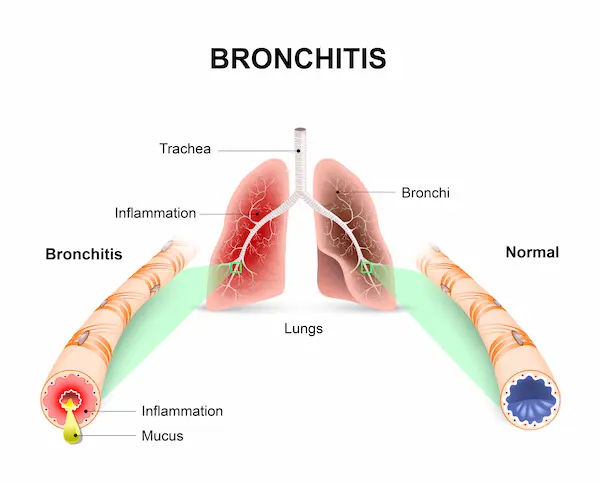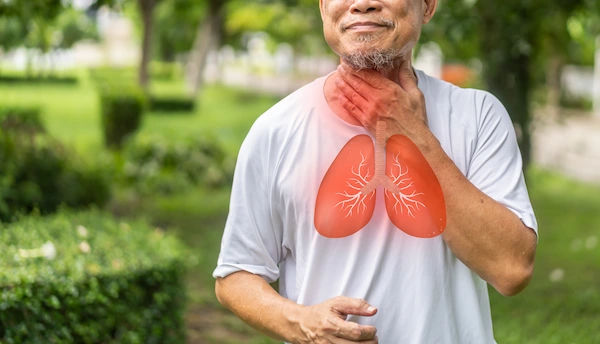What Leads To Signs Of Bronchitis?
Discover the common causes and risk factors that lead to the signs and symptoms of bronchitis. Learn about viral, bacterial, and environmental triggers.

Written by Dr. Dhankecha Mayank Dineshbhai
Reviewed by Dr. M L Ezhilarasan MBBS
Last updated on 25th Oct, 2025

Introduction
A bad cough that won’t quit can make you wonder: Is it bronchitis? Bronchitis happens when the tubes that carry air to your lungs (bronchi) get inflamed and irritated, usually after a virus. That inflammation triggers the classic signs—persistent cough, chest discomfort, fatigue, and sometimes wheezing or mucus. In most cases, bronchitis is short-lived (acute). But when cough with mucus lingers for months and recurs, it can be chronic bronchitis, a condition tied to COPD, particularly in people who smoke.
In this guide, we’ll unpack what leads to the signs of bronchitis, how to tell it apart from a simple cold or pneumonia, who’s at risk, and what treatments actually help. We’ll answer common questions like whether green mucus means you need antibiotics, how long a bronchitis cough lasts, and when to call a doctor. You’ll also find prevention tips—from vaccines to air-quality strategies—plus practical, science-backed self-care advice. If symptoms persist beyond two weeks, consult a doctor online with Apollo 24|7 for further evaluation.
What Exactly Is Bronchitis? Acute vs Chronic
Acute bronchitis is often called a “chest cold.” It’s typically triggered by a viral infection that inflames the bronchial lining and ramps up mucus production. That irritation stimulates your cough reflex, so you cough to clear the excess mucus. The cough often starts dry and then becomes more productive over several days. For most people, acute bronchitis is self-limited, with cough lasting up to 2–3 weeks, sometimes a bit longer, even after other symptoms fade. Antibiotics usually don’t help because viruses are the main cause.
Chronic bronchitis is different. It’s defined as a productive cough that lasts at least three months in a year and recurs for two consecutive years. It’s a clinical diagnosis and is one of the conditions under the COPD umbrella. Smoking remains the leading cause, but long-term exposure to dust, fumes, or air pollution can contribute. Chronic bronchitis often brings daily cough, frequent chest infections, and shortness of breath, and it may require inhaled medications and a long-term care plan.
Key distinctions you’ll see:
- Trigger: Acute bronchitis is usually viral; chronic bronchitis is driven by long-term airway irritation (often from smoking).
- Duration: Acute lasts days to weeks; chronic persists for months and recurs.
- Management: Acute focuses on symptom relief; chronic focuses on long-term lung health, smoking cessation, and preventing flare-ups.
Unique insight: One reason acute bronchitis lingers is “cough hypersensitivity.” Even after the infection clears, the cough reflex stays overactive for a while. That’s why a post-infectious cough can persist, even when you’re otherwise feeling better—an important point when deciding whether you need antibiotics (often, you don’t).
Consult a Top General Physician
The Science: How Bronchitis Inflames Your Airways
Think of your bronchial tubes as tree branches lined with delicate hair-like cilia. During bronchitis, a virus or irritant injures this lining (epithelium), sparks inflammation, and makes the glands produce extra mucus. The cilia slow down, so mucus lingers instead of being swept out efficiently. This sets the stage for the hallmark signs: cough, phlegm, wheeze, and chest tightness.
- Epithelial irritation: The lining swells, narrowing the airway and making breathing feel harder, especially during exertion. This can cause chest tightness or wheezing, particularly if you already have asthma.
- Mucus overproduction: Extra mucus thickens and pools. Your body coughs to clear it, but thick mucus can be stubborn, especially at night or early morning.
- Cilia slowdown: Damaged cilia struggle to move mucus out, prolonging symptoms even after the infection starts to resolve.
Why coughing and wheezing occur:
- Cough is a protective reflex to clear secretions and irritants from the airways. In bronchitis, the reflex can become hypersensitive, prolonging the cough.
- Wheezing results from narrowed airways. In acute bronchitis, wheeze can appear transiently; in chronic bronchitis and COPD, wheeze may be a persistent feature due to long-standing airway remodeling.
Unique insight: Mucus color can change as immune cells get to work. Green or yellow sputum does not automatically mean a bacterial infection; it often reflects neutrophils and enzymes in the mucus. This is why guidelines caution against using sputum color alone to decide on antibiotics.
What Leads to the Signs of Bronchitis?: Causes and Triggers
Viral infections drive most acute bronchitis cases. Common culprits include influenza, RSV, rhinovirus, adenovirus, and coronaviruses. These viruses irritate and inflame the bronchial lining, producing cough and mucus. During cold and flu season, clusters of acute bronchitis rise in step with viral circulation.
Bacterial causes are less common in otherwise healthy adults with acute bronchitis. When present, bacteria like Bordetella pertussis (whooping cough) can cause prolonged, severe coughing fits; atypical bacteria are occasionally implicated. Clues suggesting bacterial causes include prolonged paroxysmal coughing with whoop (pertussis), known exposure, or outbreaks. Even then, testing and targeted antibiotics, not broad use, are the way to go.
Irritants also lead to bronchitis symptoms—by directly inflaming the airways:
- Tobacco smoke (active and secondhand), vaping aerosols, woodsmoke.
- Outdoor air pollution (PM2.5, ozone) and indoor pollutants (cleaning chemicals, dust).
- Workplace exposures: dusts, fumes (e.g., welding, solvents), and agricultural particulates.
Links with asthma, allergies, and GERD:
- Asthma can flare with respiratory infections or smoke exposure, mimicking bronchitis with cough and wheeze; sometimes you have both.
- Allergies and post-nasal drip can contribute to cough and mucus.
- GERD can irritate airways via micro-aspiration, worsening cough in the setting of bronchitis.
Unique insight: The “perfect storm” for bronchitis signs often involves stacked triggers—say, a winter viral infection plus dry indoor air and recent exposure to smoke. Reducing any one of these (humidification, avoiding smoke, vaccination) can meaningfully cut symptom intensity.
Recognizing the Signs and Symptoms
Typical acute bronchitis symptoms include:
- Cough (often dry at first, then productive), commonly lasting 2–3 weeks.
- Chest soreness or tightness from frequent coughing.
- Mild wheeze or shortness of breath, especially with exertion.
- Sore throat, runny nose, low-grade fever, and fatigue at onset.
Bronchitis vs common cold vs pneumonia:
- Common cold: Upper-airway focus—runny/stuffy nose, sore throat, milder cough, usually shorter duration.
- Bronchitis: Lower-airway inflammation—persistent cough with or without mucus, chest discomfort, wheeze; fever usually low or absent.
- Pneumonia: More severe—high fever, fast breathing, significant shortness of breath, pleuritic chest pain; exam and chest X-ray support diagnosis.
Red flags that warrant immediate care:
- Shortness of breath at rest, bluish lips, severe chest pain, confusion.
- High fever >38.5°C (101.3°F), shaking chills.
- Coughing up blood, signs of dehydration (very low urine output, dizziness).
- Symptoms not improving after 2–3 weeks, or worsening after initial improvement, especially in older adults or those with heart/lung disease.
Unique insight: Pay attention to the “cough curve.” If your cough is plateauing or improving after week one, that’s consistent with viral bronchitis. If it takes a sharp turn for the worse—new fever, breathlessness—get assessed promptly to rule out pneumonia.
Who Is Most at Risk?
Smokers and vapers: Tobacco smoke is the top risk factor for chronic bronchitis and COPD, and it also worsens acute bronchitis severity and duration. Vaping aerosols can irritate airways and may provoke bronchitis-like symptoms in susceptible individuals. Even secondhand smoke exposure increases risk.
Children, older adults, and pregnancy:
- Children encounter frequent viruses and may develop bronchitis symptoms more often, particularly with RSV or flu seasons.
- Older adults have less physiologic reserve, higher pneumonia risk, and often more severe courses. Prompt evaluation is important if fever or shortness of breath appears.
- During pregnancy, immune and respiratory changes can intensify symptoms; clinicians prioritize supportive care and safe medication choices.
Chronic conditions and occupational exposure:
- Asthma, COPD, heart disease, diabetes, and immunosuppression increase risk for complications or prolonged symptoms.
- Occupational irritants (e.g., silica dust, welding fumes) can cause or aggravate bronchitis and drive chronic cough. Protective equipment and controls matter.
Unique insight: Your “exposure load” is cumulative. Reducing any one component—quitting smoking, using a high-quality mask on smoggy days, or improving workplace ventilation—can noticeably reduce the severity and frequency of bronchitis episodes.
How Bronchitis Is Diagnosed?
For most people with acute bronchitis, diagnosis relies on history and exam—no tests needed. Your clinician listens for wheezes, checks oxygen level, and looks for signs pointing to pneumonia (e.g., high fever, fast breathing, low oxygen) or alternative diagnoses (e.g., heart failure).
When tests are used:
- Chest X-ray: If pneumonia is suspected, particularly in older adults, those with significant fever, low oxygen, or abnormal lung exam.
- Viral testing: Flu or COVID-19 tests in season or during outbreaks can guide care and isolation decisions.
- Sputum tests: Rarely needed in typical acute bronchitis; may be ordered if pneumonia or unusual infections are suspected.
- Spirometry: Useful if asthma or COPD is suspected (recurrent wheeze, chronic cough, smoking history).
Telehealth and home test collection:
- If you’re unsure whether your cough is likely bronchitis or pneumonia, telehealth can triage symptoms quickly.
- If your doctor recommends basic labs to assess overall health or coexisting conditions, Apollo 24|7 offers a convenient home collection for tests like complete blood count or HbA1c, so you don’t need to leave home when you’re unwell.
If symptoms persist beyond two weeks, consult a doctor online with Apollo 24|7 for further evaluation. If your condition does not improve after trying these methods, book a physical visit to a doctor with Apollo 24|7.
Unique insight: A normal oxygen level and stable vital signs strongly support outpatient management. In borderline cases, a pulse oximeter at home can add objective data while you recover.
Evidence-Based Treatment and Self-Care
Core self-care for acute bronchitis:
- Rest and fluids: Hydration thins mucus and eases cough clearance.
- Humidification: A cool-mist humidifier can reduce throat irritation and help loosen secretions, especially at night.
- OTC symptom relief: Paracetamol/acetaminophen or ibuprofen for discomfort and fever; throat lozenges; saline nasal sprays for post-nasal drip.
- Honey can soothe coughs and may reduce nighttime coughing in children over 1 year and adults.
- Avoid honey in infants under 1 due to botulism risk.
Inhalers and medications:
- Short-acting bronchodilators (like albuterol) can help if wheezing or chest tightness is present, particularly in those with asthma/COPD.
- - Inhaled or oral steroids may be used short-term in asthma or COPD exacerbations, not routinely for simple bronchitis.
- Antibiotics are usually not recommended for acute bronchitis because viruses are the primary cause and antibiotics don’t shorten illness. They’re reserved for suspected bacterial conditions (e.g., pertussis) or clear bacterial pneumonia.
Cough suppressants: Short-term use at night can help sleep if cough is disruptive. Daytime use should be limited to allow mucus clearance.
When to consult a doctor:
If cough and bronchitis symptoms persist beyond two weeks, you have underlying heart/lung disease, or you’re getting worse rather than better, consult a doctor online with Apollo 24|7. They can evaluate whether you need an inhaler, chest X-ray, or tests, and advise on next steps.
Unique insight: “Pacing” your activities can prevent cough spirals. Short, gentle walks with nose-breathing, followed by rest and hydration, often help mobilize mucus without triggering prolonged coughing fits. Using a timed “steam and sip” routine—5 minutes of warm shower steam plus sipping warm fluids—twice daily can make a noticeable difference in comfort.
Chronic Bronchitis and Long-Term Management
Chronic bronchitis is marked by a daily, productive cough for at least three months per year, two years in a row. It’s commonly linked with COPD. Management focuses on reducing airway irritation, improving airflow, and preventing flare-ups.
Key pillars:
- Smoking cessation: The most impactful step. Quitting slows disease progression and reduces flare-ups. Combining behavioral support with medications (e.g., varenicline, NRT) boosts success.
- Maintenance inhalers: Long-acting bronchodilators (LABA/LAMA) and, in select cases, inhaled corticosteroids can reduce symptoms and exacerbations.
- Pulmonary rehabilitation: Supervised exercise and education programs improve shortness of breath, quality of life, and exercise tolerance.
- Vaccines: Annual flu and recommended COVID-19 boosters, plus pneumococcal and pertussis vaccines, reduce infection-related exacerbations.
- Exacerbation plans: Recognize early signs—rising cough, green/brown mucus, increased breathlessness—and act promptly per your clinician’s plan.
Unique insight: Even small, daily “lung health deposits” matter—2–3 brief bouts of gentle stair walking or inspiratory muscle training can improve respiratory endurance over weeks, complementing medication benefits.
Prevention: Stop Bronchitis Before It Starts
Vaccinations:
Influenza and COVID-19 vaccines lower the risk of the viral illnesses that commonly precede acute bronchitis and can trigger COPD flare-ups. Pneumococcal and pertussis vaccines are recommended for eligible groups.
Air quality strategies:
- Check air quality index (AQI) and limit outdoor exertion on high-pollution days.
- Use high-quality masks in smog or smoke events; improve indoor ventilation and reduce indoor pollutants (tobacco, incense, harsh aerosols).
Hygiene and daily habits:
- Wash hands, avoid close contact when sick, and practice cough etiquette.
- Maintain hydration and consider humidification in dry seasons.
- Don’t smoke; avoid secondhand smoke and vaping aerosols.
Unique insight: A “winter airway plan” pays off—get vaccinated, set a reminder to check AQI, place a humidifier by your bedside, and stock simple remedies (saline spray, lozenges, acetaminophen) before the season starts.
Complications, Red Flags, and When to Seek Care?
Most acute bronchitis resolves without complications. However:
- Post-infectious coughs can linger 3–8 weeks due to airway hypersensitivity; it usually fades with supportive care.
- Bacterial pneumonia sometimes follows viral infections, particularly in older adults or those with chronic disease—watch for worsening fever, shortness of breath, or chest pain.
- COPD exacerbations can be triggered by bronchitis episodes; early treatment can prevent hospitalizations.
Seek urgent care if you develop:
- Difficulty breathing, chest pain, lips/fingertips turning blue, confusion.
- High fever or severe dehydration.
- Coughing up blood.
- Worsening symptoms after initial improvement.
If symptoms persist beyond two weeks, consult a doctor online with Apollo 24|7 for further evaluation. If your condition does not improve after trying these methods, book a physical visit to a doctor with Apollo 24|7.
Conclusion
Bronchitis can be miserable, but understanding what leads to its signs helps you make smart decisions. In most cases, acute bronchitis follows a viral infection that inflames the bronchial tubes, leading to cough, mucus, and chest discomfort for up to a few weeks. Supportive care—rest, hydration, humidification, and simple symptom relievers—usually does the trick. Antibiotics are seldom needed, and mucus color alone isn’t a reliable guide. If you have chronic bronchitis, especially related to smoking or pollutant exposure, long-term strategies like smoking cessation, maintenance inhalers, pulmonary rehab, and vaccinations can reduce flare-ups and improve day-to-day breathing.
Watch for red flags like breathing difficulty, high fever, chest pain, or worsening symptoms after initial improvement. If signs persist beyond two weeks or you have underlying lung or heart
disease, consult a doctor online with Apollo 24|7 for tailored advice and, if needed, prescriptions or tests. With the right care plan and preventive steps—vaccines, smoke avoidance, and air-quality awareness—you can shorten the course of acute bronchitis, avoid complications, and protect your long-term lung health.
Consult a Top General Physician
Consult a Top General Physician

Dr. Abhishek Ranjan
General Practitioner
4 Years • MBBS
Kolkata
VDC Clinic, Kolkata

Dr. Harshendra Jaiswal
General Physician/ Internal Medicine Specialist
12 Years • MBBS , MD (General medicine)
Kolkata
108 DHANA DHANVANTARI Clinic, Kolkata
(25+ Patients)

Dr. Vishal Kumar H
General Physician/ Internal Medicine Specialist
8 Years • MBBS, master class in critical care medicine, Advanced Post Graduate Diploma in Non Invasive Cardiology, certificate course in Cardiovascular Disease & Stroke, Certificate course in Common Mental Disorder
Bengaluru
Apollo Clinic, Basavanagudi, Bengaluru
Dr. Paras Gangwal
General Physician/ Internal Medicine Specialist
28 Years • MBBS,MD General Medicine
Delhi
Dr Paras Gangwal Clinic, Delhi

Dr. Tapabrata Ray
General Physician/ Internal Medicine Specialist
4 Years • MBBS,DGM,CPMeC,ACMDC
Kolkata
MCR SUPER SPECIALITY POLY CLINIC & PATHOLOGY, Kolkata
Consult a Top General Physician

Dr. Abhishek Ranjan
General Practitioner
4 Years • MBBS
Kolkata
VDC Clinic, Kolkata

Dr. Harshendra Jaiswal
General Physician/ Internal Medicine Specialist
12 Years • MBBS , MD (General medicine)
Kolkata
108 DHANA DHANVANTARI Clinic, Kolkata
(25+ Patients)

Dr. Vishal Kumar H
General Physician/ Internal Medicine Specialist
8 Years • MBBS, master class in critical care medicine, Advanced Post Graduate Diploma in Non Invasive Cardiology, certificate course in Cardiovascular Disease & Stroke, Certificate course in Common Mental Disorder
Bengaluru
Apollo Clinic, Basavanagudi, Bengaluru
Dr. Paras Gangwal
General Physician/ Internal Medicine Specialist
28 Years • MBBS,MD General Medicine
Delhi
Dr Paras Gangwal Clinic, Delhi

Dr. Tapabrata Ray
General Physician/ Internal Medicine Specialist
4 Years • MBBS,DGM,CPMeC,ACMDC
Kolkata
MCR SUPER SPECIALITY POLY CLINIC & PATHOLOGY, Kolkata
More articles from Bronchitis
Frequently Asked Questions
Does green or yellow mucus mean I need antibiotics for bronchitis?
Not necessarily. Mucus color often reflects immune activity, not bacteria. Most acute bronchitis is viral, and antibiotics aren’t routinely recommended. If you have a high fever, breathing trouble, or worsening symptoms, seek medical advice.
How long does a bronchitis cough last?
The cough from acute bronchitis commonly lasts 2–3 weeks, sometimes longer due to post-infectious airway sensitivity. If your cough persists beyond two weeks, consult a doctor online with Apollo 24|7.
What helps bronchitis at night?
Try a cool-mist humidifier, warm fluids, honey (if age >1), and propping your head to reduce post-nasal drip. If wheezing keeps you up, an inhaler may help—ask a clinician whether that’s appropriate for you.
When are antibiotics appropriate for bronchitis?
Antibiotics may be used for specific bacterial causes (e.g., suspected pertussis) or if pneumonia is diagnosed. They are not routinely indicated for typical viral bronchitis.
How do I prevent bronchitis?
Get flu and COVID-19 vaccines, avoid smoke and vaping, check air quality, practice hand hygiene, and maintain good indoor air. For chronic bronchitis/COPD, follow your inhaler plan and consider pulmonary rehab.




